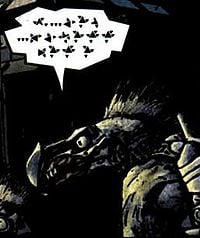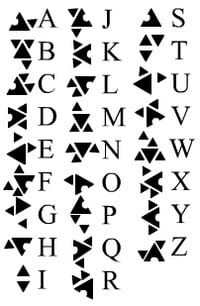Covenant languages
From Halopedia, the Halo wiki

- "Their language doesn't translate in a literal manner, and each word has multiple meanings."
- — Cortana[1]
Members of the Covenant had their own unique languages. The races did not speak the same language due to evolutionary design restrictions; for example, the Kig-Yar cannot speak anything other than a hissing sound. To facilitate easier communications between member species, translation software was used on Covenant ships to decipher words.
However, the main Covenant language seems to be Sangheili, as most of the Covenant names are Sangheili words (e.g. Unggoy)[2].
The languages in their original form are heard in Halo: Combat Evolved. In Halo 2, their words are translated for the convenience of the player. Elites in Halo: CE spoke a deep, warbling tongue. This was achieved by reversing the voice acting of David Scully. The ever popular "Wort, wort, wort!" shouted by many Elites during gameplay is actually "Go, go, go!" reversed and sped up.[3] The hissing-like language of the Jackals is actually the English language reversed. This, and the other Covenant languages (Drones, Hunters), have remained the same since Halo 2.
Written Language
Conversations from the Universe contains letters written by the Prophets of Truth and Supposition. The writing in these letters resembles English, with various alterations. This may be due to a connection between Covenant or Forerunner texts and English texts, or simply thanks to literary license on Bungie's behalf.
Text, or writing, in the Covenant appears to be mostly triangle shapes and composed almost completely of equilateral triangles, except for a single dash-like shape that seems to serve the function of a period. The triangular characters have been seen oriented both in the horizontal left-to-right direction and in a vertical right-to-left direction. It should be noted that the horizontal form of this text was useful for both Brutes and Jackals in Halo: Uprising Issue 1 so far. Whether all of the species that are or were in the Covenant use this form of text is currently unknown.
Before the release of Halo 2, the official website at Halo2.com was made to look like a Covenant computer complete with a Covenant language. This language was a simple cipher with the triangular characters. In addition to Halo2.com, a released wallpaper contained triangular characters that made use of this cipher.
After the Halo2.com site, the cipher changed. Two wallpapers were released with an entirely new cipher still using the triangular characters. Neither this cipher or the previous one have been used subsequently, though the triangular characters are still commonly used.
Languages
Unggoy
- Main article: Unggoy
Their native language is composed of dog-like barks, squeaks, and grunts. Though largely unintelligible to most humans, translation software is able to decipher the meanings of these.[4] The word "Unggoy" itself is not a word from their vocabulary - rather, it is the Sangheili name for their species.[2] Unggoy are also fully capable of speaking a variety of human languages, a fact that they take great pride in.
Kig-Yar
- Main article: Kig-Yar

Kig-Yar language seems to consist of a range of hisses, growls, screeches, snarls, and squawks, though it is intelligible to other members of the Covenant.[5][6][7][8] It is likely that they speak the Sangheili language, the distortion caused by their birdlike bodies.
Huragok
- Main article: Huragok
Huragok are the only known species in the Covenant to possess more than one language. One is a verbal language, consisting of whistles and chirps, used to convey orders between Huragok and their superiors, usually a Ship Master and their crew[9]. The second is a sign language, using the different shapes and positions of tentacles to convey different meanings. The Huragok sign language can be learned by other species, including Unggoy, though their inferior finger dexterity makes forming the shapes a cumbersome task.[8]
Yanme'e
- Main article: Yanme'e
Yanme'e use a system of chirps, clicks and buzzes to convey information between other members of the hive, rubbing their wings together to produce such sounds, similar to Earth crickets. Translator units are required for other species to understand them.[8] Combat units will usually elect an attache to serve as a translator, learning how the other races communicate and relaying the relevant information to the other Yanme'e.[10]
Lekgolo
- Main article: Lekgolo
Lekgolo communication is problematic at best. Between different Mgalekgolo forms they use resonance that only their own species can hear and understand.[8] For inter-species communications, Mgalekgolo are capable of speaking at least the Sangheili language.[2]
Jiralhanae
- Main article: Jiralhanae
The native Jiralhanae language is animalistic, incorporating a wide range of sounds from growls and barks, to full-out howls and roars,[8][7] though as seen in Halo: Contact Harvest, Brutes also express emotions through scents and musks. Jiralhanae are also capable of speaking the Sangheili language.[verification needed].
Sangheili
- Main article: Sangheili
Though originating with the Sangheili, their language has come to be the Covenant lingua franca, used to connect the different races and species. It is seemingly based upon the Forerunner language[2], likely pieced together from fragments recovered on Forerunner relics.
A few words, and their meanings, are known:
- Unggoy - Grunt
- Kig-Yar - Jackal
- Sangheili - Elite
- Yanme'e - Drone
- Jiralhanae - Brute
- Lekgolo - Hunter
- San' Shyuum - Prophet
- Huragok - Engineer (taken from the Forerunner name "Huragok")
- Wort - Go.[3]
San' Shyuum
- Main article: San' Shyuum
Based on religious sermons by the Prophet of Regret on Delta Halo, the native Prophet language is similar to Medieval Gregorian-style chanting.[6] Whether this is spoken by all San' Shyuum, or if it is a special dialect for religious purposes is unknown.
Sources
- ^ Halo: First Strike, page 156
- ^ a b c d Halo: Ghosts of Onyx
- ^ a b EliteSpeak
- ^ Conversations From The Universe
- ^ Halo: Combat Evolved
- ^ a b Halo 2
- ^ a b Halo 3
- ^ a b c d e Halo: Contact Harvest
- ^ Halo: First Strike
- ^ Halo Encyclopedia
